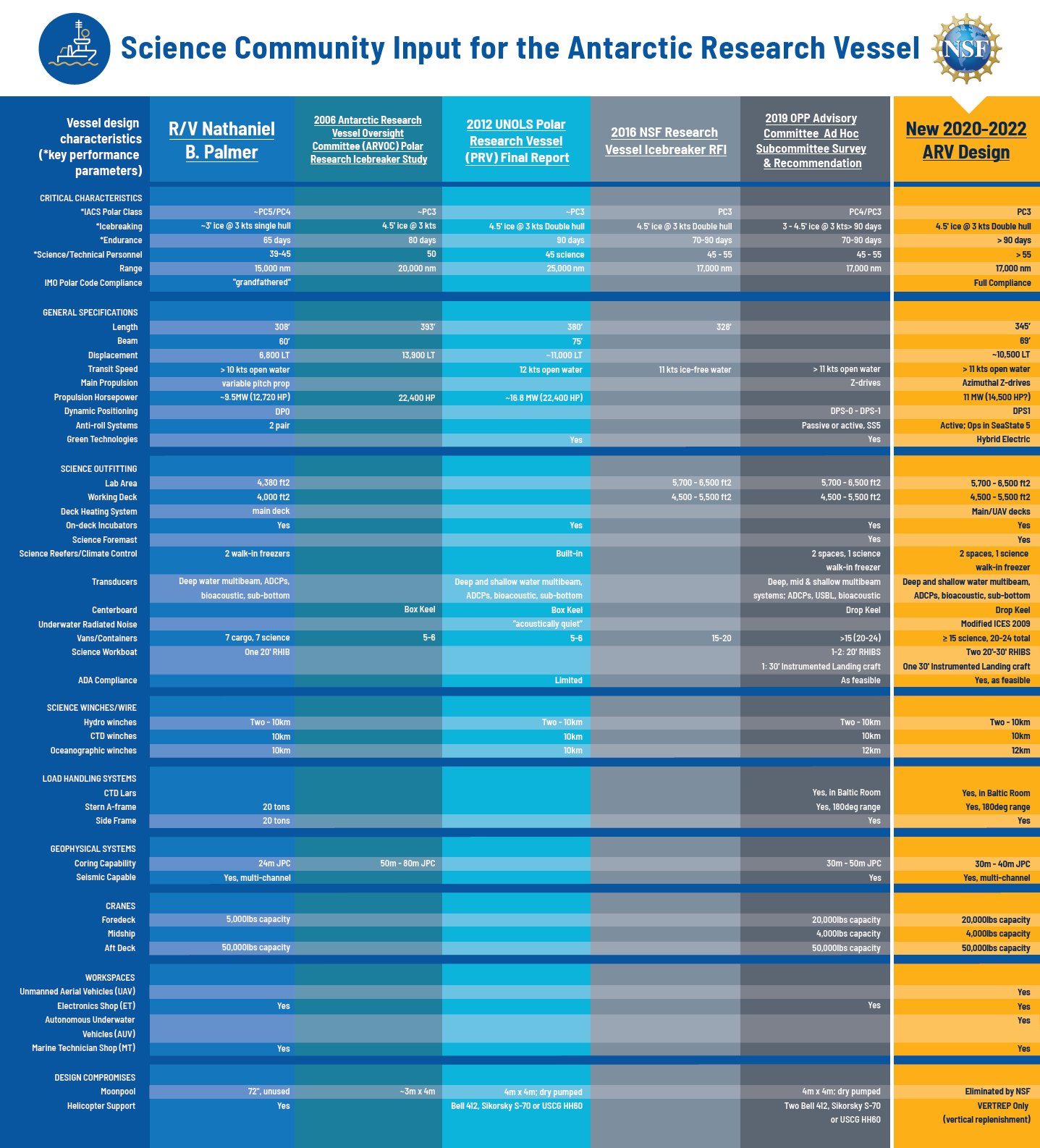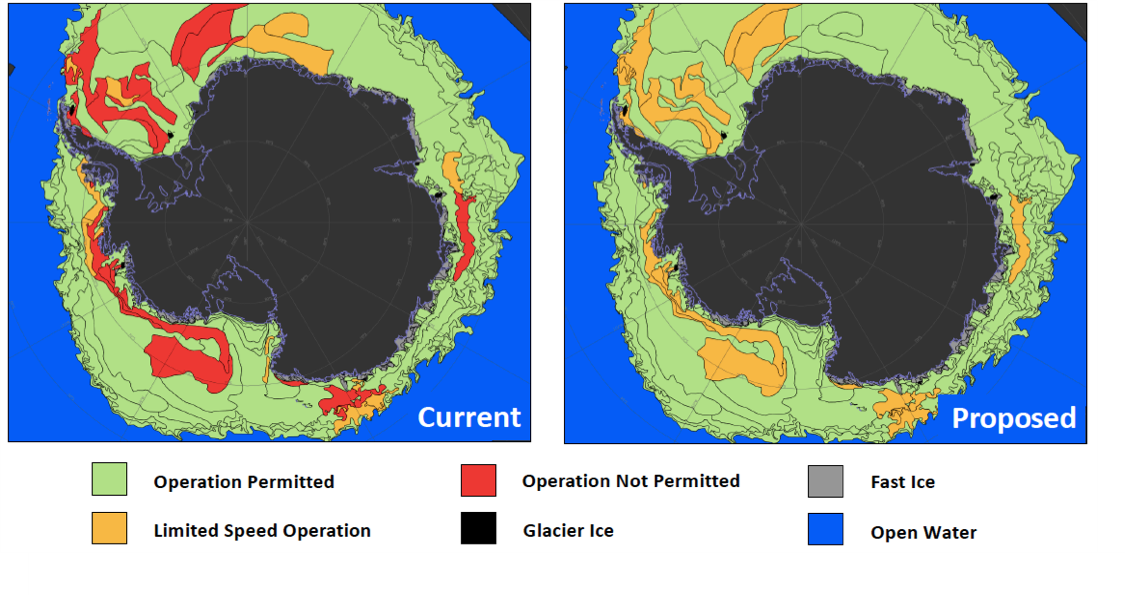New Antarctic Research Vessel (ARV)
Community Design Input and Engagement
Science Advisory Subcommittee
Tasking
The ARV Science Advisory Subcommittee (SASC) is made up of sea-going researchers, and research vessel technical and operational experts from the academic community who provide recommendations and advice to the U.S. National Science Foundation regarding ARV's interim design reviews. Members of the SASC attend all interim design reviews, as well as, participate in working groups, integrated project teams, and configuration management. The science community is encouraged to reach directly out to SASC members using their email addresses below.
Emeritus
-
Dr. Bruce Appelgate
University of California San Diego/Scripps -
Ms. Alice Doyle
University-National Oceanographic Laboratory System (UNOLS) -
Dr. Amy Leventer, Chair
Colgate University -
Dr. Carlos Moffat
University of Delaware -
Dr. Kristin O'Brien
University of Alaska Fairbanks -
Dr. Patricia Quinn
NOAA/PMEL -
Dr. Clare Reimers
Oregon State University -
Dr. Deborah Steinberg
Virginia Institute of Marine Science
SASC Reports
- ARV Science Advisory Sub-Committee of the OPP Advisory Committee, Report on DR #1, May 23 2022
- ARV Science Advisory Sub-Committee of the OPP Advisory Committee, Report on DR #2, September 2022
- ARV Science Advisory Sub-Committee of the OPP Advisory Committee, Report on DR #3, November 2022
- Progress of Antarctic Research Vessel Design, February 2023
- ARV Science Advisory Sub-Committee of the OPP Advisory Committee, Report on DR #4, March 2023
- ARV Science Advisory Sub-Committee of the OPP Advisory Committee, Report on DR #5, September 2023
Frequently Asked Questions (FAQs)
Please click the questions below to view answers. If you have additional questions not represented here, please use the Contact Us form.
Research vessels are essential facilities for supporting U.S. coastal and ocean science in the Southern Ocean and the waters around Antarctica. For 30 years the Nathaniel B. Palmer (NBP) has been the icebreaking research vessel used by the U.S. Antarctic Program to support ocean science in this region. Though still in good condition, by the time a new icebreaking research vessel can be delivered the NBP will have well exceeded its normal service life. Developing a new research vessel will ensure uninterrupted science operations in the Southern Ocean and the Antarctic for decades to come. The new research vessel will have advanced capabilities, and will allow researchers to venture further into the ice-covered waters around Antarctica, with larger science parties, and for longer periods of time.
The new, world-class ARV will include modern scientific tools coupled with enhanced capabilities compared to those of the RVIB Nathaniel B. Palmer (NBP), will enable polar researchers to better address decadal research priorities. To see the features added to the ARV please review the Capability Summary (Placemat) found here. Additionally, listed below are the key performance parameters (KPP) for the ARV:
| Parameter | Requirement | Threshold Value |
|---|---|---|
| Icebreaking | The capability to independantly break ice | ≥4.5 feet @ ≥3 knots |
| Meet requirements for Polar Code notation | Polar Code PC3 | |
| Endurance | Maximum endurance without replenishment | ≥90 days underway |
| Science and Technical Personnel | Provisions for berthing, messing, sanitation, and scientific workspaces | Crew and ≥55 science and technical personnel |
ARV will be able to conduct multi-disciplinary science expeditions to some of the most challenging areas around Antarctica. This Includes the Eastern Antarctic, the ice-choked waters off of the Larsen ice shelf and Amundsen Sea, and provide access to regions around Antarctica during the winter months. In addition, the ARV's decks and state of the art labs are being designed to be capable of reconfiguration for each mission's specific needs.
The figure below illustrates an increased icebreaking ability that would allow access to new targeted regions of scientific interest.
Upon delivery, the Antarctic Research Vessel (ARV) will become the flagship of the U.S. National Science Foundation's U.S. Antarctic Program (USAP). ARV will expand NSF science mission goals by increasing access to those ice protected hard-to-reach study sites, allowing for much longer mission durations, and delivering more scientists and equipment to the Antarctic theatre. Unique ARV design features being developed during the preliminary design phase of this program include:
- Advanced piston coring system featuring the largest sampling core length in the U.S. research fleet at 40 to 50 meters
- Expansive open aft working deck - Nearly twice that of the Nathaniel B. Palmer.
- Dedicated marine service bay for the staging and maintenance of oceanographic research equipment and autonomous watercraft
- Forward flight deck purpose-built for uncrewed aerial vehicles (drones) supporting both scientific sampling and vessel ice navigation
- Laboratory van and storage container carrying capacity of 20-24 ISO containers (20 ft length)
- Meteorological and Atmospheric focused laboratory spaces
- A minimum of 20 days waste water holding capacity for extended mission durations in environmentally sensitive areas
- Integration of green ship technologies including a waste heat recovery system, increased fuel efficiencies through the use of hybrid-power battery systems, and "smart" heating and air conditioning system in all accommodations
- Superior icebreaking capability through the use of state-of-the-art hull design and advanced ice radar equipment
Upon delivery, the Antarctic Research Vessel (ARV) will become the flagship of the U.S. National Science Foundation's U.S. Antarctic Program (USAP). ARV will expand NSF science mission goals by increasing access to those ice protected hard-to-reach study sites, allowing for much longer mission durations, and delivering more scientists and equipment to the Antarctic theatre. Unique ARV design features being developed during the preliminary design phase of this program include:
- Advanced piston coring system featuring the largest sampling core length in the U.S. research fleet at 40 to 50 meters
- Expansive open aft working deck - Nearly twice that of the Nathaniel B. Palmer.
- Dedicated marine service bay for the staging and maintenance of oceanographic research equipment and autonomous watercraft
- Forward flight deck purpose-built for uncrewed aerial vehicles (drones) supporting both scientific sampling and vessel ice navigation
- Laboratory van and storage container carrying capacity of 20-24 ISO containers (20 ft length)
- Meteorological and Atmospheric focused laboratory spaces
- A minimum of 20 days waste water holding capacity for extended mission durations in environmentally sensitive areas
- Integration of green ship technologies including a waste heat recovery system, increased fuel efficiencies through the use of hybrid-power battery systems, and "smart" heating and air conditioning system in all accommodations
- Superior icebreaking capability through the use of state-of-the-art hull design and advanced ice radar equipment
The environmentally fragile regions of the Southern Ocean and waters around Antarctica require careful analysis of the impact the ARV will have on these regions. The NSF ARV team remain committed to designing a vessel that will offer the least impact to the environment while still being able to perform its scientific missions. For an in-depth explanation of the measures implemented to limit the ARV's impact to the environment please refer to the ARV Climate Study Report and the ARV Green Ship Alternatives Report. The links to both reports can be found here: ARV Climate Study Report and ARV Green Ship Alternatives Report.
The ARV is estimated to be delivered by the middle of 2031. For more information regarding the timeline of the ARV project, please refer to the project timeline graphic found here: ARV Project Timeline
The ARV will be capable of seafloor geotechnical drilling, such as MeBo or RD2.
The ARV will support a wide suite of unoccupied aerial systems for both science and operational purposes. In addition, the forward flight deck will be capable of Vertical Replenishment (VERTREP).
No, science will not be gapped between the end of life for the Nathaniel B. Palmer (NBP) and the commissioning of the ARV. The OPP understands the importance of science and has a plan in place to maintain the NBP charter until the ARV is complete.
No. Regular passenger movements and re-supply of Palmer Station will be carried out through commercial supply vessels. ARV will be capable of berthing at the new Palmer Station pier in support of science, and capable of delivering cargo, personnel, and fuel. More information on those efforts will be released in 2023.
No, ARV is a science icebreaker rather than an escort/channel heavy icebreaker. Its hull is optimized to support the science systems and research operations in Antarctica, rather than cutting and maintaining a channel for other ships.
The ARV will be capable of operating in the two main Polar Regions of the world, the Artic and the Antarctic, but is expected to be dedicated to Southern Ocean research.
Yes, the ARV will be built in the United States.
The NSF is currently exploring various approaches to operating the ARV, and the ship operator will be selected when funds for construction have been appropriated, but no decision has been made at this time.
An in-depth explanation of the design trade-offs leading to the moonpool elimination can be found in the Project Memorandum - IBRV Moonpool Requirement report. The link to this report can be found here: Project Memorandum - IBRV Moonpool Requirement.pdf.
An in-depth explanation of the design trade-offs leading to the helideck elimination can be found in the Project Memorandum - IBRV helideck report. The link to this report can be found here: Project Memorandum - IBRV helideck report.pdf.
Requirements Development
Evolution of Capabilities

Science Community Input for the Antarctic Research Vessel; Evolution of Capabilities
Credit: NSF, Terri Edillon
Download the ARV Input Graphic
Ad-Hoc Committee Report
For more than ten years, various elements of the US polar research community have addressed the ship support requirements that would be necessary for future USAP research. This report collects key recommendations from prior studies, community advice and their own practical experience.
View the Ad-Hoc Committee Report
NSF Decisions Summary Memo
Evolution of Science Mission Requirements (SMR) for Antarctic Research Vessel (ARV)



